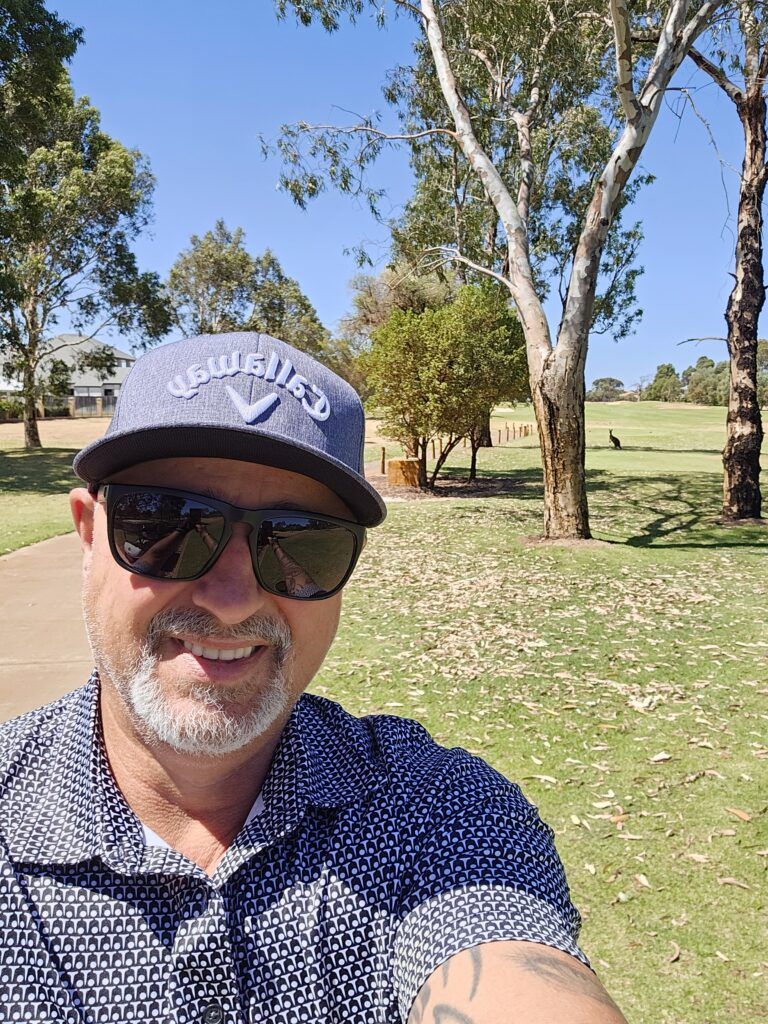Welcome to the world of article writing! If you’re diving into the realm of content creation, this post is your treasure map. Here, we’ll unveil “Article Writing Tips for Beginners” which are sure to elevate your skills practically overnight. So, buckle up and get ready for a transformative journey!
Article Writing Tips for Beginners: Understanding Your Audience
Identifying Your Target Readers
Knowing your audience is a foundational step in our arsenal of article writing tips for beginners. Think of it as setting the stage before the grand performance. When you understand who you’re writing for, you’re not just throwing words into the void; you’re engaging in a conversation. It’s like knowing whether you’re talking to a room full of seasoned scholars or high school students – the difference is crucial.
Firstly, get into the shoes of your readers. What are their interests, needs, and pain points? It’s like being a chef who knows whether their guests prefer spicy or mild before starting to cook. Use social media, forums, and comments on similar articles to get a sense of their preferences. Tools like Google Analytics can also provide invaluable insights into your audience’s demographics and online behavior. It’s like having a backstage pass to the minds of your readers.

Next, understand their reading habits. Are they looking for quick, practical tips, or do they prefer deep dives into topics? This knowledge is a game-changer in how you approach your writing. If you’re crafting article writing tips for beginners, chances are your readers are looking for straightforward, easy-to-understand advice rather than complex, jargon-filled dissertations.
Finally, don’t forget to consider the feedback. Engage with your readers through comments, emails, or social media. It’s like having a focus group providing constant feedback on your performance. By understanding their responses, you can fine-tune your approach, making your articles more relevant and engaging over time.
Remember, the better you know your audience, the more effectively you can communicate with them. It’s a critical component in the toolbox of article writing tips for beginners – one that transforms good writing into great communication.
Article Writing Tips for Beginners Tailoring Content to Audience Needs
Tailoring your content to resonate with your readers is a pivotal piece of the puzzle in our guide on article writing tips for beginners. Think of it like being a DJ at a party; you need to play the tunes that get your audience dancing. Whether they groove to the beats of in-depth analysis or move to the rhythm of snappy summaries, your content should match their tempo.
First things first, consider the language and tone. If you’re addressing professionals, a formal, polished style might be the way to go. But if your audience is younger or more casual, then a relaxed, conversational tone can be more engaging. It’s like choosing the right outfit for an occasion – it should fit the setting and audience expectations.
related article – beginners blueprint: how to start writing for a blog with ease
Hey there, future blogging superstar! Welcome to your first step towards becoming a blogging sensation. Today, we’re diving into the exciting world of blogging – from zero to hero. So, if you’ve ever wondered how to start writing for a blog… Read More>>

Also, pay attention to the structure of your content. For readers who prefer detailed analysis, use a comprehensive approach. Dive deep into topics, back your points with data, and don’t shy away from the nitty-gritty details. On the other hand, if your readers love quick reads, stick to concise paragraphs, bullet points, and lots of headings. It’s all about making the content digestible and skimmable for them.
Remember, the key here is flexibility. Being able to adapt your writing style to suit different audiences is a valuable skill in article writing, especially for beginners. It’s not just about what you say, but how you say it. This ability to customize content is what can make your articles stand out in the crowded world of online information.
In the end, tailoring your content to audience needs is about creating a connection. When readers feel that your article speaks directly to them, that’s when you’ve hit the jackpot. Keep this in mind as you craft your pieces and watch as your engagement levels soar!
Choosing the Perfect Topic
Finding Your Niche
Discovering your niche in the vast world of article writing is like uncovering your superpower. It’s a crucial step in our “Article Writing Tips for Beginners” guide. Your niche is your sweet spot – the topic or area where your passion and knowledge intersect. It’s like having a secret ingredient in your writing recipe that makes your content uniquely yours.
Start by reflecting on your interests and passions. What topics do you find yourself naturally drawn to? Are you a tech enthusiast, a fitness guru, or maybe a culinary connoisseur? Your niche should be something you love talking about, something that excites you. It’s like choosing a favorite flavor – it has to be something you genuinely enjoy.
related article – top blogging niches with high profit potential
Ah, the world of blogging! Where words are your currency and your niche is your kingdom. But let’s face it, not all kingdoms are created equal, especially in terms of… Read More>>

Next, consider your expertise and experience. What are you knowledgeable about? Maybe you have professional experience in a certain field or a hobby you’ve been indulging in for years. Combining your passion with your expertise is like having a winning lottery ticket in the world of article writing for beginners.
Now, research the demand. Is there an audience for your niche? Use tools like Google Trends or keyword research tools to gauge interest. It’s like scouting the market before setting up a shop. You want to make sure there’s a crowd interested in what you have to offer.
Finally, think about your unique perspective. What new or different angle can you bring to your niche? Maybe it’s your personal experiences, your humorous take on things, or your ability to explain complex topics simply. This uniqueness is what will make your writing stand out.
Remember, finding your niche might take some time and exploration, but once you do, it’ll feel like unlocking a new level in the game of article writing. It gives your writing direction and purpose, a crucial tip for beginners eager to make their mark in the writing world.
Balancing Interest and Expertise

Striking the right balance between what captivates you and what you’re an expert in is a critical ingredient in our “Article Writing Tips for Beginners” recipe. Imagine you’re a chef in a kitchen. Your interest is the recipe you want to try, and your expertise is your skill in cooking. The perfect dish requires a harmony of both.
Start by identifying what you love. What topics do you find yourself endlessly researching or talking about? This passion is your fuel; it keeps your writing engine running. When you write about what fascinates you, it’s like adding spice to your writing – it brings flavor and excitement.
Now, mix in your expertise. What areas do you have substantial knowledge or experience in? This could be your professional field, a personal hobby, or a subject you’ve studied extensively. Writing about what you know lends credibility and depth to your work. It’s like having a well-stocked pantry; you have all the ingredients for great content.
The magic happens when you find the intersection of these two. That’s your sweet spot for article writing. If you’re passionate about sustainable living and you’re an expert in gardening, for example, your niche might be eco-friendly gardening practices. It’s like finding a recipe that’s both delicious and nutritious – it satisfies both your palate and your health.
Remember, not every interest needs to match your expertise perfectly. Sometimes, your enthusiasm to learn about a new topic can compensate for the lack of expertise, and vice versa. It’s about finding a balance that works for you and resonates with your audience.
This balance is what sets successful article writers apart. It allows you to create content that’s not only informative but also engaging and personal. As a beginner, finding this balance can be a game-changer, turning your articles from good to great.
Exploring My Writing Journey

As a passionate writer, I’ve embarked on an incredible journey across four unique websites, each representing a topic close to my heart. These websites aren’t just platforms for my words; they’re windows into my passions and expertise.
Discover My Creative Canvas
When you explore my work below, you’ll step into a world where every article is a labor of love. Writing for me is not just a task; it’s an opportunity to share my knowledge, experiences, and insights with you. Whether it’s delving into the realms of technology, exploring the wonders of nature, or unraveling the secrets of personal development, I’ve poured my heart and soul into every piece.
Your Invitation to Dive In
Each website is a unique tapestry of ideas and stories waiting to be explored. So, I invite you to take a journey with me through these digital domains, where you’ll find articles that inform, inspire, and entertain. It’s not just about the words on the screen; it’s about the experiences, discoveries, and moments we’ll share together.
So, without further ado, let’s dive into my writing world and uncover the treasures of knowledge and passion I’ve crafted for you.
And of course, the website you are at now, The Blogger Boss
Looking through these I am always encouraged by where my writing started and where it is at now!
Mastering the Art of Engaging Headlines
Crafting Compelling Headlines

Mastering the art of crafting compelling headlines is a cornerstone among article writing tips for beginners. Your headline is the first handshake with your reader, the make-or-break moment that decides whether your article gets read or skipped. Think of it as the flashy sign outside a store – if it’s dull, no one walks in.
A headline should be a tantalizing teaser of what’s to come. It’s like the trailer for a movie; it should excite, intrigue, and invite your audience in. Begin with understanding what grabs your audience’s attention. Does a direct how-to headline work best for them, or do they prefer something mysterious that piques curiosity?
Keywords play a big role here too. Include your primary keyword, like “Article Writing Tips for Beginners,” in a way that feels natural. It’s not just for SEO; it’s about making it clear to your reader (and search engines) what your article is about. Think of your keyword as the main ingredient in your headline recipe – it’s essential, but it needs to blend well with the other elements.
Keep it short and sweet. Long, winding headlines can lose your reader’s interest. Aim for brevity while packing a punch. A good headline strikes a balance between being informative and engaging. It’s like a tightrope walker balancing informativeness and allure.
And lastly, experiment and test different headlines. The beauty of digital writing is the ability to change and adapt. Use tools like A/B testing to see which headlines resonate most with your readers. It’s a process of trial and error, but it can lead to headline gold.
So, remember, a great headline is like the front door to your article – make it inviting, and they’ll want to see more. For beginners eager to captivate their audience, nailing the headline is a step you can’t afford to skip. And guess what, if you’re reading this article my headline has done its job!

Headline Tools and Testing
Diving deeper into our arsenal of article writing tips for beginners, let’s explore the realm of headline tools and testing. In our digital age, your headline is like your digital handshake – it needs to be firm, confident, and memorable. But how do you ensure your handshake stands out in a sea of digital content?
Enter the world of headline tools. There are numerous online tools designed to analyze and score your headlines. These tools, like CoSchedule’s Headline Analyzer or Advanced Marketing Institute’s Headline Analyzer, evaluate your headline based on factors like emotional resonance, word balance, and SEO. It’s like having a personal headline coach, guiding you to create that perfect headline.
But the learning doesn’t stop there. Testing your headlines is crucial. In the digital sphere, this is often done through A/B testing – a method where you try two different headlines for the same content to see which performs better. Tools like Google Optimize or social media advertising platforms can help you run these tests. It’s like a science experiment with your content, where the data guides your decisions.
Remember, what works for one audience might not work for another. That’s why testing is so important. It helps you understand your specific audience better. Are they drawn to headlines with numbers, questions, or bold claims? Testing reveals these preferences.
As a beginner in article writing, don’t be afraid to experiment. Try different headline styles and structures. Use the tools available, but also trust your instincts. Sometimes, the best headlines come from a sudden spark of creativity.
In summary, think of your headline as the crown jewel of your article. Polish it with the help of tools and refine it through testing. It’s a process, but one that can significantly boost the impact of your articles.
Structuring Your Article for Maximum Impact
Organizing Content Flow
Ensuring your article flows smoothly, much like a meandering river, is a vital aspect of article writing tips for beginners. A well-structured article not only enhances reader engagement but also makes your content more digestible. Here’s how you can guide your readers through your article with ease and grace.
First and foremost, start with a clear outline. Think of it as your article’s blueprint. This outline should map out your introduction, main points, and conclusion. It’s like planning a journey; you need to know your route before you set off. This structure serves as a guide to ensure your content stays on track and each point seamlessly leads to the next.
Use clear and concise headings and subheadings. Not only do they break the text into manageable chunks, but they also provide a sneak peek into what each section is about. It’s like road signs on a highway; they tell you what to expect ahead.
Transition sentences are your best friends. They are the bridges between your ideas, ensuring your reader doesn’t get lost in a sea of words. A good transition smoothly ushers your reader from one idea to the next, maintaining the flow of your narrative.
Don’t forget the importance of paragraph length. In the digital world, readers often skim content. Short, impactful paragraphs are easier on the eyes and more likely to keep your reader engaged. It’s like serving a meal in courses instead of all at once; it’s more appealing and digestible.
Remember, the goal is to keep your reader moving through your article with interest and ease. Like a river, your content should have a natural rhythm and flow that carries the reader from start to finish without them even realizing the journey they’re on. Mastering content flow is a crucial part of article writing tips for beginners, turning a collection of ideas into a cohesive, compelling narrative.
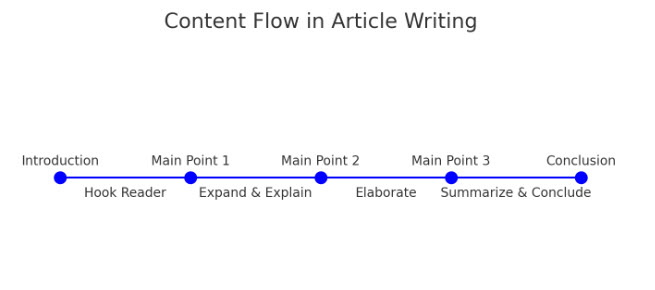
Here is a graph that visually explains the concept of content flow in article writing. This diagram illustrates the typical structure of an article:
- Introduction: This is where you ‘Hook the Reader’. It’s essential to start with something that grabs the reader’s attention.
- Main Point 1: Here, you ‘Expand & Explain’ the first key point or idea.
- Main Point 2: This stage is about ‘Elaboration’. You delve deeper into the subject, providing more detailed information.
- Main Point 3: You continue to ‘Elaborate’, adding further depth and detail to your article.
- Conclusion: Finally, you ‘Summarize & Conclude’ your article. This is where you tie all the points together and reinforce the main message or takeaway.
This flow ensures a logical and engaging progression through your article, keeping the reader interested from start to finish.
Breaking Down Complex Ideas
Transforming complex ideas into accessible content is a crucial technique in our list of article writing tips for beginners. It’s about taking something intricate and breaking it down into bite-sized, understandable pieces. Think of it as a chef skillfully deconstructing a gourmet dish into a simple, home-cooked meal.
The first step is to understand the complex idea thoroughly yourself. It’s like assembling a puzzle; you need to see the big picture before you can explain the individual pieces. Dive deep into the topic, research extensively, and don’t shy away from asking experts or looking up complex terms. Your understanding will be the foundation upon which you simplify the concept for others.
Next, think about how to present the idea in the simplest terms. Use analogies and metaphors to relate complex ideas to everyday experiences. It’s like translating a foreign language into a vernacular; make it relatable and easy to grasp.
Structure is your ally. Break down the topic into clear, logical sections or steps. If you’re explaining a complex process, outline it step-by-step. Use bullet points, lists, and subheadings to organize the information. This helps readers follow along without getting overwhelmed. It’s like creating a roadmap for a journey through a dense forest – it guides the reader through without getting lost.

Lastly, remember to gauge your audience’s understanding. Avoid jargon and technical terms unless absolutely necessary. And if you do use them, explain them. Your goal is to educate, not to show off your vocabulary. It’s like speaking to someone who’s just starting to learn a new language – patience and simplicity are key.
Breaking down complex ideas is like unfolding a story – it should be engaging, informative, and, above all, understandable. It’s a skill that not only improves your writing but also enhances your ability to think and communicate clearly – a vital part of article writing tips for beginners.
Engaging Writing Style: A Key Article Writing Tip for Beginners
Developing a Unique Voice

In the realm of article writing tips for beginners, finding and honing your unique writing voice is like discovering your secret superpower. It’s what sets your writing apart and stamps it with your personal brand. Think of it as the distinct flavor you add to your writing dish that makes it unmistakably yours.
Start by exploring your personality. Are you witty, serious, or somewhere in between? Your writing voice should be a reflection of who you are. It’s like choosing your outfit for the day; it should fit your style and make you feel comfortable. If you’re naturally humorous, let that shine through your writing. If you’re more serious and factual, that’s fine too. Authenticity resonates with readers.
Read widely and observe how different authors express themselves. Notice the nuances in their writing that make them unique. It’s like being in a music store, listening to various genres. You start to understand what resonates with you and what doesn’t.

Then, practice, practice, practice. The more you write, the more your unique voice will emerge. Experiment with different styles and tones until you find what feels right. It’s like trying out different instruments until you find the one that sings to your soul.
Remember, your writing voice might evolve over time, and that’s perfectly okay. It’s a part of growing as a writer. What’s important is that it remains true to you. Your unique voice is your signature in the world of writing; it’s how readers will come to recognize and appreciate your work.
So, as a beginner in article writing, cherish the journey of discovering your voice. It may take time, but it’s an exciting exploration that will add depth and personality to your writing. Embrace it, and watch how it transforms your content from ordinary to extraordinary.
Balancing Informative and Engaging Content

Striking the perfect balance between educating your readers and keeping them engaged is a key pillar in our “Article Writing Tips for Beginners.” It’s about mixing the nutritional value of information with the irresistible taste of engagement. Just like a chef blends different flavors to create a perfect dish, your job as a writer is to blend information with entertainment.
Start by understanding the value of the information you’re providing. Ask yourself, “What new knowledge or perspective am I offering to my readers?” This is your content’s backbone – it’s like the nutritious vegetables in a meal. Ensure that every piece you write adds something valuable to your reader’s knowledge bank.
Then, add the spices of engagement. This can be through storytelling, humor, or relatable examples. It’s about presenting your information in a way that captivates your readers. Imagine you’re telling a story to a friend – you’d naturally use elements that keep them interested, right?
Balance is crucial. Too much information without engagement can feel like a lecture, while too much entertainment without substance can seem frivolous. It’s like balancing sweet and savory flavors – both are needed in just the right amounts.
Use visuals, anecdotes, and questions to make your content more relatable and digestible. Remember, even the most serious topics can be made interesting with the right approach. It’s like adding a twist to a classic recipe to give it a new, exciting flavor.
In summary, blending informative and engaging content is an art. As you grow in your writing journey, you’ll learn to adjust the mix to suit different topics and audiences. This balance is what will make your articles not only informative but also enjoyable to read – a vital skill in article writing tips for beginners.
Grab your Blogger Boss Content Calendar Below.
SEO Best Practices
Keyword Research and Integration
Incorporating the phrase “Article Writing Tips for Beginners” into your content is more than just a SEO strategy; it’s about making your article a go-to resource for newcomers in the writing world. Let’s unravel how you can sprinkle this key phrase throughout your content seamlessly, without sacrificing the quality of your writing.
Firstly, remember that your primary goal is to provide value to your readers. The keyword should feel like a natural part of the conversation, not forced or out of place. It’s like adding seasoning to a dish – it should enhance the flavor, not overpower it. When you focus on creating helpful and relevant content, integrating keywords like “Article Writing Tips for Beginners” becomes much more intuitive.
Next, sprinkle the keyword in key parts of your article such as the introduction, headings, and conclusion. This not only helps with SEO but also reinforces the focus of your content. Imagine it as signposts along a trail, guiding and reminding your readers of the path they’re on.
Variety is the spice of life, and this holds true for keyword usage as well. Use variations or synonyms of your main keyword to avoid redundancy. It keeps the content fresh and engaging while still being SEO-friendly. Think of it like playing a melody with different notes – the tune remains recognizable, but it’s more pleasant to the ear.
Finally, don’t overdo it. Keyword stuffing can make your article sound robotic and unappealing. Your readers are here for a smooth, enjoyable read, not a repetitive keyword marathon. It’s about finding that sweet spot – using the keyword enough for SEO, but not so much that it hinders the reader’s experience.
In essence, weaving “Article Writing Tips for Beginners” into your article should be like threading a needle – done with precision and care. It’s a skill that enhances both the visibility and the value of your content, making it a win-win for you and your readers.
My #1 Choice for keyword research and value for money is Jaaxy!
Try researching a keyword with Jaaxy below.
On-Page SEO Techniques
Mastering on-page SEO techniques is a vital chapter in our “Article Writing Tips for Beginners” guidebook. It’s not just the words you write, but how you present them that can make a significant difference in your article’s search engine visibility. Think of it as not just preparing a great dish, but also presenting it appealingly on the plate.
First and foremost, pay attention to your title tag and meta description. These are the first things a search engine and potential readers see. Your title should be catchy and include your main keyword, “Article Writing Tips for Beginners,” in a natural way. It’s like the name of a book – it should be intriguing enough to make someone want to open it.
Your meta description is like a movie trailer for your article. It should be compelling and give a sneak peek of what the reader can expect, all while incorporating your main keyword seamlessly. This small snippet can significantly impact your click-through rate.
related article – boost your online visibility and drive traffic
As a beginner’s guide for SEO, we will explain why it’s important to understand that SEO (Search Engine Optimization) is crucial for website traffic and online visibility. Without SEO… Read More>>
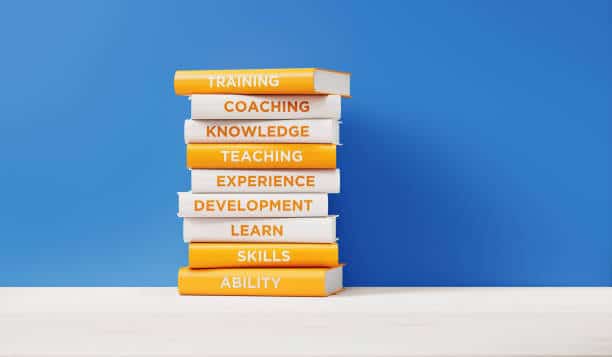
Headings and subheadings are not just for structuring your content; they are also crucial for SEO. They give search engines a clear idea of the main topics in your article. Including your focus keyword in one or two headings can amplify your SEO efforts. It’s like putting up signposts that guide both the reader and search engines through your content.
Internal and external linking is another key strategy. Link to your own relevant articles to keep the reader engaged with your content and include links to authoritative external sources to add credibility. This practice is akin to networking at a party – you’re introducing your readers to other guests (articles) who can provide additional value.
Lastly, don’t forget about image alt text. If you use images, make sure they have descriptive alt text that includes your keyword. This not only helps visually impaired readers understand the image but also let’s search engines know what the image is about. It’s like describing a painting to someone over the phone.
In sum, on-page SEO goes beyond mere content creation. It encompasses how you structure, link, and present your article. By optimizing every element, you increase your chances of ranking higher in search results, a crucial goal in article writing tips for beginners.
Effective Use of Visuals in Article Writing
Enhancing Articles with Images and Graphics
Incorporating visuals into your articles can dramatically boost their appeal and effectiveness, a key point in our “Article Writing Tips for Beginners.” Just as a picture is worth a thousand words, the right image or graphic can speak volumes and complement your writing beautifully.


2 Images Using a AI Generating Tool
Start by choosing images that are directly relevant to your content. If you’re writing about home gardening tips for beginners, for instance, include images of basic gardening tools, a beginner’s garden setup, or step-by-step process shots. These visuals serve as practical examples, making your article more relatable and easier to follow.
Graphics like infographics can also be incredibly effective. For an article about healthy eating habits, an infographic summarizing key points like portion sizes, or a balanced diet chart can be both informative and visually engaging. It’s a great way to present complex information in an easily digestible format.
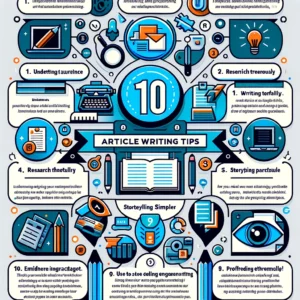
Remember, the quality of your visuals is crucial. High-resolution images that are clear and professionally presented can enhance your article’s perceived value. It’s like dressing up your content in its Sunday best – it just looks more appealing.
Also, consider the placement of your visuals. Breaking up long sections of text with relevant images or graphics can keep your readers engaged and make your article more skimmable. It’s akin to taking a scenic route on a long drive; the views (images) make the journey (reading) more enjoyable.
Lastly, always ensure that you have the right to use the images you select. Utilize royalty-free image sources like Unsplash or Pixabay, or create your own graphics with tools like Canva. It’s like using ingredients in your kitchen; make sure they are ones you’re allowed to use.
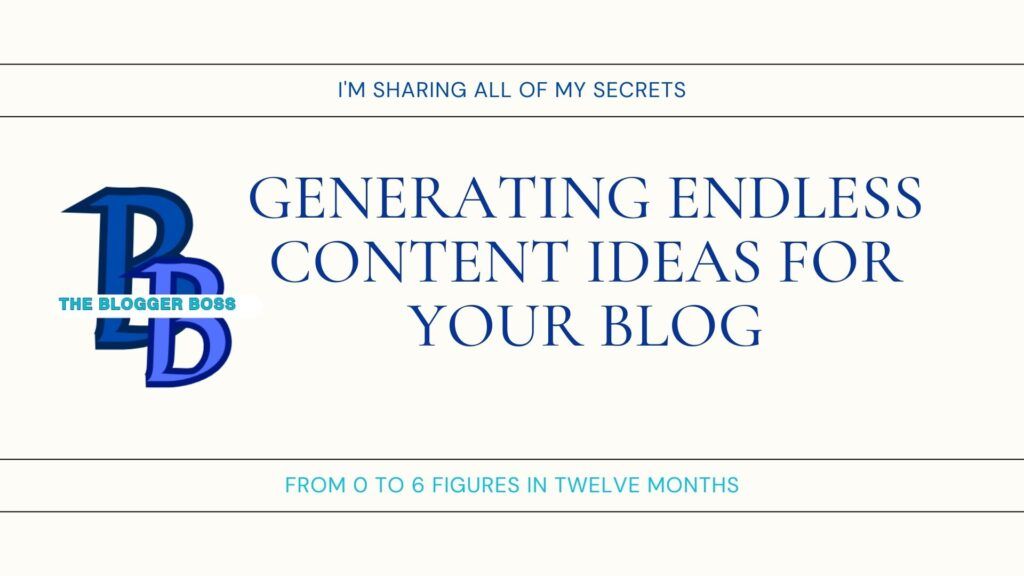
Created on Canva in 3 Minutes
Incorporating well-chosen and high-quality visuals is a game-changer in article writing, especially for beginners. They not only enhance the aesthetic appeal of your article but also aid in conveying your message more effectively, making your content stand out in the bustling world of online information.
Accessibility and Optimization
Incorporating visuals into your articles is fantastic, but it’s equally crucial to ensure they are accessible and web-friendly – a cornerstone in our “Article Writing Tips for Beginners.” It’s not just about creating eye-catching images; it’s about being considerate to all readers, including those with disabilities.
First and foremost, always provide alternative text (alt text) for your images. Alt text is like a spoken description of the image for visually impaired readers who use screen readers. When adding alt text, be descriptive but concise. For example, if your image shows gardening tools, your alt text can be “Assorted gardening tools for beginners.” It’s like narrating the content of a picture to someone who can’t see it.
Consider the file format of your visuals. For photographs, use commonly supported formats like JPEG or PNG. For graphics and diagrams, vector formats like SVG are great choices. Avoid using obscure formats that might not be compatible with all browsers or devices.
Optimize your images for web loading speed. Large image files can slow down your website, leading to a poor user experience. Use compression tools to reduce file sizes without compromising image quality. It’s like packing your suitcase efficiently for a trip – you want to carry everything you need without making it too heavy.
I like to use TinyPng to compress my images and the best part is its FREE! Save the link below to your bookmarks/favorites.
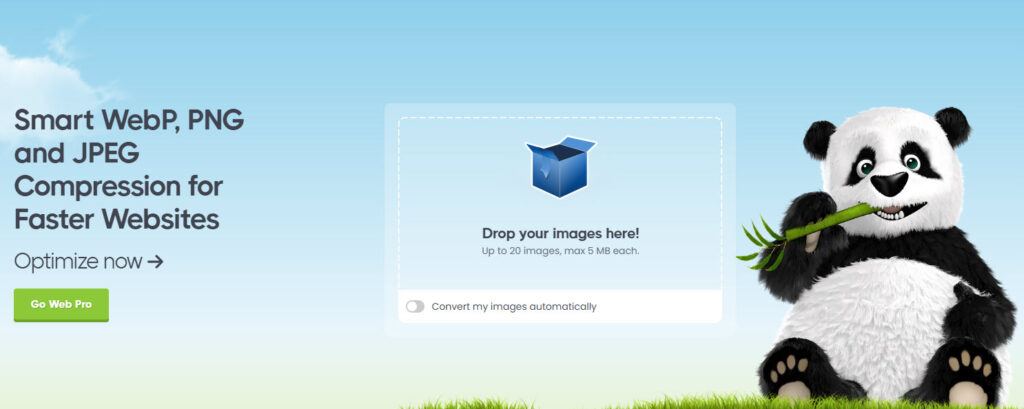
Tinypng for Compressing Images to Get a Faster Performing Website!
Ensure that your visuals are responsive. In other words, they should adapt to different screen sizes and orientations, providing a good experience on both desktop and mobile devices. Responsive design is like having an adjustable tool that fits perfectly in various hands.
Lastly, test your article’s accessibility by using web accessibility tools and guidelines. This ensures that everyone, regardless of their abilities, can access and enjoy your content. Think of it as ensuring that your book is available in multiple languages – you want to reach a diverse audience.
Incorporating these accessibility and optimization practices not only makes your content more inclusive but also aligns with web standards. It’s a win-win situation – you make your content accessible to a broader audience while improving its overall quality.
The Art of Editing and Proofreading
Self-Editing Techniques
Editing is the secret ingredient that transforms good writing into something truly great. In our “Article Writing Tips for Beginners,” we’ll share valuable tips and techniques for effective self-editing, helping you refine your work to perfection.
- Take a Break: After you’ve finished writing, give your article some space. Step away for a while, whether it’s a few hours or a day. This break allows you to return to your work with fresh eyes, making it easier to spot errors and areas for improvement.
- Read Aloud: Reading your article aloud can help you catch awkward sentences, typos, and grammatical errors. It also gives you a sense of how the article flows and whether it sounds natural.
- Check for Clarity: Ensure that your writing is clear and concise. Beginners often tend to overcomplicate sentences. Simplify complex ideas and remove unnecessary words. Think of it as decluttering your writing.
- Consistency Matters: Check for consistency in style, tone, and formatting. Ensure that headings, fonts, and spacing are uniform throughout your article. Consistency creates a polished and professional look.
- Watch for Typos and Grammar: Typos and grammar mistakes can undermine your credibility. Use grammar-checking tools and proofread meticulously. It’s like giving your article a final polish before presenting it to your readers.
- Eliminate Repetition: Avoid repeating the same points or ideas. If you’ve made a key point in one section, avoid reiterating it unnecessarily. It’s about keeping your content concise and engaging.
- Get Feedback: Don’t hesitate to seek feedback from others. A fresh perspective can uncover issues you might have missed. Fellow writers or even friends and family can provide valuable insights.
- Structure and Organization: Check the structure of your article. Ensure it has a clear introduction, body, and conclusion. Subheadings should guide the reader smoothly through the content.
- Fact-Check and Cite Sources: If you’ve included facts or statistics, verify their accuracy. Ensure you’ve properly cited your sources to maintain credibility.
- Stay True to Your Voice: While editing, maintain your unique writing voice. It’s what makes your work distinctive. Editing shouldn’t strip away your personality; it should enhance it.
Remember, self-editing is a skill that improves with practice. The more you refine your articles, the better your writing becomes. Embrace the editing process as a crucial step in crafting exceptional content.
Seeking External Feedback
In the journey of article writing for beginners, seeking external feedback is like having a treasure map that guides you to hidden gems of improvement. It’s the extra pair of eyes and fresh perspectives that can make all the difference in refining your writing.
- The Value of Fresh Eyes: When you’ve been immersed in your writing, it’s easy to become blind to its flaws. External feedback offers a new viewpoint, catching issues you might have missed, from typos to unclear sentences.
- Where to Find Feedback: Don’t limit yourself in seeking feedback. Fellow writers, writing groups, or online writing communities can be invaluable resources. Friends and family can also provide a reader’s perspective.
- Constructive Criticism: Embrace constructive criticism with an open mind. It’s not about tearing your work apart; it’s about highlighting areas for improvement. Constructive feedback helps you grow as a writer.
- Specific Questions: When seeking feedback, ask specific questions. Do you want input on clarity, structure, or overall impact? Specific questions elicit targeted responses that you can act upon.
- Multiple Opinions: Don’t rely solely on one person’s feedback. Collect input from multiple sources. It helps you identify recurring issues and gives you a more balanced understanding of your writing’s strengths and weaknesses.
- Consider the Audience: Think about who your target audience is. Feedback should align with your intended readership. Different perspectives matter but prioritize those that match your audience’s expectations.
- Implement Changes Thoughtfully: After receiving feedback, take time to digest it. Don’t rush to make changes. Consider each suggestion and decide whether it aligns with your vision for the article.
- Feedback Is a Gift: Remember that feedback is a gift. It’s an opportunity to grow and refine your skills. Embrace it as an essential step in your writing journey.
Seeking external feedback can be a game-changer for beginners. It not only improves the quality of your writing but also fosters a sense of community and growth. So, don’t hesitate to share your work and invite others to be part of your writing adventure.
Promoting Your Article: A Crucial Step for Beginners
Leveraging Social Media
In the world of article writing for beginners, social media is your best friend and greatest ally. It’s not just a place to share cat videos (although those are fun too); it’s a powerful tool for promoting your articles effectively.
Building Your Online Presence: Social media platforms offer a stage to showcase your writing talents. Create profiles on platforms like Twitter, LinkedIn, Facebook, or Instagram. Use a professional photo, write a compelling bio, and include links to your articles. Think of your profile as the billboard that introduces you to the digital world.
Share Your Expertise: Don’t just use social media to post selfies (although, again, feel free to do so). Share your knowledge and insights about article writing. Offer quick tips, intriguing snippets from your articles, or thought-provoking questions related to your niche. It’s like giving your followers a taste of your writing prowess.
Engage with Your Audience: social media is a two-way street. Interact with your followers by responding to comments and messages. Engage in conversations about writing-related topics. Building relationships with your audience can turn them into loyal readers. It’s akin to mingling at a writing conference – you’re building connections.
Promote Your Articles Strategically: When sharing your articles, don’t just drop links and run. Craft compelling captions that entice your audience to click. Use relevant hashtags to increase discoverability. Share your articles at optimal times when your audience is most active. It’s about creating a buzz around your work.
Join Writing Communities: Many social media platforms host writing communities and groups. Join these communities to connect with fellow writers, exchange ideas, and share your articles. It’s like having a writing circle that supports and inspires you.
Measure and Adapt: Most social media platforms provide analytics tools. Use them to track the performance of your posts and articles. Which topics resonate the most with your audience? When do you get the most engagement? Use these insights to refine your social media strategy.
Social media isn’t just a megaphone for your articles; it’s a dynamic space to connect, learn, and grow as a writer. Embrace these platforms as valuable allies in your writing journey, and watch your articles reach new heights.
Building an Email List
In the realm of article writing for beginners, your email list is your secret weapon and a direct line to your most dedicated audience members. It’s not just a list of names and email addresses; it’s a community of readers who are genuinely interested in what you have to say.
Offer Valuable Content: Your email list subscribers are looking for something special. Use your articles as a gateway to offer exclusive content. This could be in the form of downloadable guides, e-books, or in-depth insights that only your subscribers get access to. It’s like having a VIP club for your most loyal readers.
Opt-in Forms: Make it easy for readers to join your email list by strategically placing opt-in forms on your website or within your articles. These forms should be inviting and promise something valuable in return for their email address. Think of it as extending a warm invitation.
Segment Your List: Not all subscribers are the same. Segment your email list based on their interests or engagement levels. This allows you to send targeted content that resonates with specific groups. It’s like tailoring your messages to different tastes at a buffet.
Engage and Nurture: Building an email list isn’t just about collecting emails; it’s about building relationships. Regularly engage with your subscribers by sending newsletters, updates, or even personal anecdotes related to your writing journey. Nurturing these connections turns one-time readers into long-term fans.
Respect Privacy: Always respect your subscribers’ privacy. Clearly communicate how often you’ll send emails and what type of content they can expect. Make it easy for them to unsubscribe if they wish. Trust is like a fragile crystal – once broken, it’s hard to mend.
Measure and Optimize: Use email marketing analytics to measure the performance of your emails. Track open rates, click-through rates, and conversion rates. This data helps you understand what works and what needs improvement. It’s like having a compass to navigate your email strategy.
Building an email list isn’t just about numbers; it’s about building a community of engaged readers who value your content. It’s a powerful tool in your arsenal, enabling you to connect with your audience on a deeper level and keep them eagerly awaiting your next article.
FAQ: Article Writing Tips for Beginners
As you dive into the world of article writing, it’s natural to have questions along the way. In this FAQ section, we’ll address some common queries that often come up when exploring the art of writing articles, especially for beginners. Let’s get straight to it:
How Do You Write an Article With no Experience?

Writing articles with no prior experience is absolutely possible. Start by choosing topics you’re passionate about or have some knowledge of. Research thoroughly, outline your ideas, and write from the heart. Don’t worry about perfection at first; practice makes progress. As you gain experience, your writing skills will naturally improve.
What Should the First Paragraph of an Article be?

The first paragraph of your article, often referred to as the introduction, should grab your reader’s attention. Begin with a captivating hook—a thought-provoking question, an intriguing fact, or a relatable anecdote. Clearly state the purpose or thesis of your article, setting the stage for what your readers can expect. A compelling first paragraph sets the tone for the entire piece.
Can You Write About Something You’ve Never Experienced?

Yes, you can write about topics you’ve never personally experienced. Research plays a crucial role here. Dive into credible sources, interview experts, or gather information from trusted references. Use your imagination and empathy to convey the topic authentically. While direct experience is valuable, research and empathy can help you write convincingly about a wide range of subjects.
These FAQs address some of the initial concerns that beginners often have when venturing into the world of article writing. Remember, writing is a skill that improves with practice, so don’t be afraid to start, learn, and grow as a writer.
Article Writing Tips for Beginners Conclusion
Congratulations! You’ve embarked on a journey to become a better writer, armed with valuable “Article Writing Tips for Beginners.” As you wrap up this article, remember that every great writer was once a beginner, just like you. The path to becoming a skilled wordsmith begins with taking that first step, and you’ve already done that.
Start Where You Are: It’s easy to feel overwhelmed when you’re just starting, but remember that every writer, even the most famous ones, began with a blank page. Embrace your current skill level, and don’t be afraid to make mistakes. Writing is a journey of continuous improvement.
Use What You Have: You don’t need fancy equipment or a perfectly organized workspace to write effectively. All you need is your creativity, passion, and the willingness to put words on paper. Don’t wait for the perfect conditions; start writing now.
Do What You Can: Writing is both an art and a craft. It takes practice and dedication. Set achievable goals for yourself, whether it’s writing a certain number of words each day or completing a specific project. Small, consistent efforts can lead to significant progress.
Embrace Your Unique Voice: In the world of writing, your unique voice is your superpower. Don’t try to mimic others; instead, embrace what makes your writing distinctly “you.” Your voice is what sets you apart and makes your work authentic.
Keep Learning: Writing is a lifelong learning process. The tips you’ve gathered in this article are just the beginning. Explore new genres, read widely, and seek feedback to continually refine your skills.
Stay Inspired: Writing can be both challenging and rewarding. During moments of writer’s block or self-doubt, remember why you started writing in the first place. Stay inspired by the world around you, the stories waiting to be told, and the impact your words can have on others.
In conclusion, the journey of a writer is filled with ups and downs, but it’s a journey worth taking. As you apply these “Article Writing Tips for Beginners,” you’ll notice improvements in your writing skills, and your confidence will grow. So, take that next step, keep your pen moving, and remember that every word you write brings you one step closer to becoming the writer you aspire to be. Happy writing!
Behind every great endeavor stands a visionary, and Blogger Boss is no exception. Mark, the founder of Blogger Boss, is more than just a figurehead; he’s a mentor, a guide, and a fellow traveler on the road to blogging success. Mark’s philosophy is simple: your success is his success. With years of experience navigating the highs and lows of the blogging world, Mark brings a wealth of knowledge and a genuine passion for teaching to the table.
Through one-on-one coaching sessions, Mark offers personalized advice tailored to your blog’s unique needs and goals. Whether you’re wrestling with technical issues, seeking clarity on your content strategy, or looking for ways to monetize your passion, Mark is there, every step of the way, to ensure your journey is not just fruitful but enjoyable.
